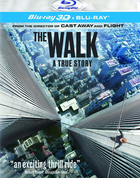BLU-RAY REVIEW

Walk, The 3D
Featured In Issue 204, February 2016
Based on a true story and the book To Reach The Clouds by Philippe Petit, The Walk follows Philippe Petit (Gordon-Levitt), a young dreamer who brings together a band of unlikely international recruits to achieve the impossible: a wire walk in the immense void between the World Trade Center towers. With little more than nerve and blind ambition, and guided by his real-life mentor, Papa Rudy (Kingsley), Petit and his ragtag crew overcome daunting physical obstacles, betrayals, dissension, countless close calls, and overwhelming odds to beat the system and execute their mad plan. (Gary Reber)
Special features include the featurettes Pillars Of Support (HD 08:27), First Steps—Learning To Walk The Wire (HD 09:11), and The Amazing Walk (HD 10:48); seven deleted scenes (HD 05:44); upfront previews; and an UltraViolet digital copy.
The 2.40:1 1080p MVC 3D picture is a conversion performed by Legend3D. The imagery exhibits natural depth and perspective, with perfectly natural dimensionality. The 3D perspective really defines the scale and the vast distance from the top of the towers to the ground. And the relationship of the wire to the points of connection and the distance between the two towers is so realistic in 3D. Nothing is exaggerated, and with the exception of an accidental fall off the wire at one of the towers, there are no out-of-screen visuals. People and objects generally display natural volume and scale. The imagery initially is in black-and-white, with accents in extremely desaturated hues, and then progresses to full color and exhibits warm and rich hues. The exterior settings are bright and vivid, while the interior settings are dimly lit. Still, shadow delineation is decent and black levels are deep. Contrast is good and well balanced. Resolution is generally good, though, the darker scenes appear softly focused due to the dim lighting. But during brighter segments, detail is revealing of fine textures, facial features, hair, and objects. (Gary Reber)
The DTS-HD Master Audio™ 5.1-channel soundtrack nicely builds toward a climax with a compelling music score featuring Sly And The Family Stone in some segments, a wonderful jazz score in others, and a beautiful Alan Silvestri orchestral score, which dominates the soundtrack during the latter half of the storytelling. The music, except for the Sly segments, is well recorded with a wide and deep soundstage that extends aggressively to the surrounds. Atmospherics and sound effects complement the visual realism and generally occupy the frontal soundstage. Bass extension is never exaggerated but always sounds natural, both with regard to the music and to the atmospherics and sound effects. Nearly at the end, a police helicopter circles the soundfield above for dramatic effect. Dialogue is spatially integrated, both when French and English is spoken, and the narrative is nicely frontal positioned. (Gary Reber)

 then "Add to Home Screen"
then "Add to Home Screen"